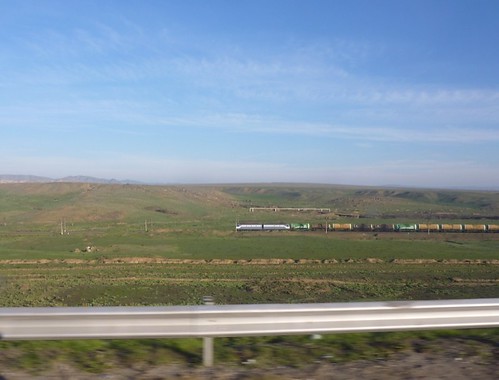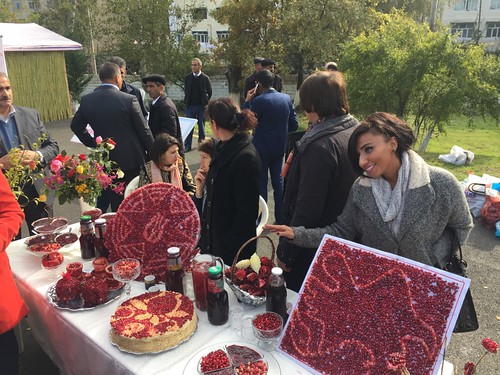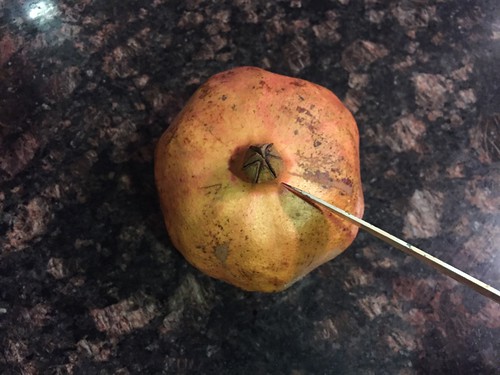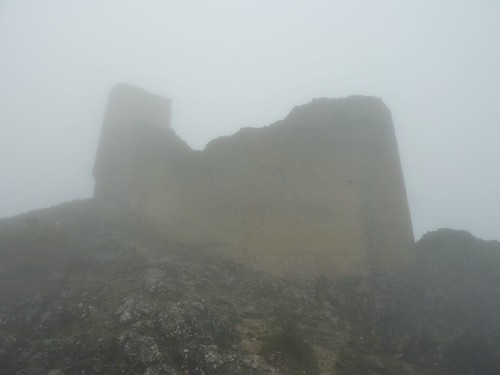After the previous week’s damp and misty outing, one might think I’d shy away from excursions for a bit. Dry out. Put my feet up. Enjoy a quiet Saturday. Then again, one might not know that the week after I visited Chirag Gala was the week of the annual pomegranate festival, and Sabina and Bag Baku were offering a day trip including transport, breakfast and, one had to assume, a lot of pomegranates. Pomegranates are, of course, one of the most traditional foods of Azerbaijan and are grown in many areas. One of those is Goychay, home of the Pomegranate Festival, and our goal for the day’s trip.
Goychay is quite a ways from Baku - the trip there was about 3 hours long, and started very early. This was fine on the way there, when the sun was shining and there was scenery to look at. I found the landscape weirdly familiar, as would anyone who’s driven across the prairies.
The Bag Baku group this time was surprisingly diverse; I think this is the first time I’ve been the only native English-speaker in a tour group. We had people from Azerbaijan, Poland, Egypt, Germany, Switzerland, Singapore and Iran. Like I said, diverse. After arriving we all sat down to a traditional Azeri breakfast at a local restaurant, out in the late fall sunshine at one big table. The menu was pretty standard: sliced tomato and cucumber to start, along with some salty local cheese and lots and lots of bread, served with butter and honey. This was followed by hard boiled eggs in the shell and some alarming looking pink wieners boiled in their plastic wrappers. And of course lots and lots of tea. There was, however, one stand-out offering that I was delighted to discover: qaymaq! Astute Go Stay Work Play Live Readers will immediately notice the linguistic similarity with Serbian kajmak, and it turns out both are pronounced the same way and are a dairy-based sort of spread. However, while I thought that Serbian kajmak was more towards the butter end of the spectrum, Azeri qaymaq is certainly more like cream. Thick, unsweetened and maybe just a touch sour. Azeri creme fraiche perhaps? Whatever the case, it was delicious on bread with a drizzle of honey. And I’ve now noticed it on the supermarket shelves as well, hiding in plain sight all this time! It’s on my list to try again, though I hesitate to make it a regular part of my diet if only because it is really just very very thick cream and I have a limited number of pairs of jeans and I am already finding one pair a tad on the uncomfortably snug side.
But back to the pomegranates. After we were fortified with bread and qaymaq, Sabina let us loose at the festival site and we agreed to meet up again four hours later. Even at the time I suspected that four hours was an ambitious amount of time to spend at a small local festival, but off I went. The site was the local outdoor stadium, and when we arrived at about noon the place was already bustling. Around the outside of the running track there were dozens of folding tables set up with people crowded around so I pushed in to see what the fuss was about.
It was an odd yet heartwarming display. Table after table of local people who’d taken the bountiful pomegranate harvest and tarted it up in odd and unexpected ways. There were also lots of plain pomegranates on display, and dishes of Nar Sherab, a sort of savoury pomegranate sauce that’s served with fish or grilled meat. (“Nar” is the Azerbaijani word for pomegranate. Short and to the point, which, given the popularity and ubiquity of the fruit here, is handy).
It took about half an hour to make a circuit of the track, and that included stopping the buy a small keychain souvenir half way around. (A hand carved wooden Maiden Tower, 4 AZN.) I also stopped at a stall to pick up some shower gel and hand soap made by a company that does really nice pomegranate bath products and was having a big big sale. Still, even after lingering at the pomegranate wine stall (No samples! Damn!) and doubling back to pick up Sabina and ask her a bunch of questions, there was still a LOT of time to kill, leaving me plenty of time to wander through another area full of food stalls, and, of course, people selling pomegranates.
But here’s the thing that really struck me about the pomegranate festival. It was very… homogenous. In a place with such a remarkable bounty/glut of pomegranates, I’d expected to see people doing all kinds of wonderful and interesting things with them. Pomegranate cakes and cookies. Pomegranate molasses and jam. Pomegranate t-shirts. Pomegranate hats. Pomegranate lip gloss. All the kinds of things you’d expect from a 21st century harvest festival in the western world. Instead, it felt like everyone was doing the same thing. You could buy pomegranates in many different varieties, or pomegranate juice, or nar sherab. With very few exceptions, that was it. The same was true with the food stalls. I'm used to seeing everything from cupcakes to jerk chicken at a festival site. Here, you could get kebabs. Or kebabs. Or, for a change, you could have a kebab. True, they were doing both the minced meat lule kebab and the chunks-of-meat on a skewer kind as well. And there were a couple of different meats available. Also, very popular among the kids was an offering of a large plain bun split open and filled with a cold wiener sliced long ways into quarters, with some kind of red sauce added (I’m guessing nar sherab, perhaps?). It reminded me of that popular kid’s treat - cold uncooked wiener. And there were sweets, all pre-packaged. And tea. Very little diversity of any kind.
Our time at the pomegranate festival eventually ran out, about 3 hours after one might have wished, but not before I bought a few pomegranates. These included some less common pale yellow varieties, including one very large one that I paid an extortionate 4 manat for. A lot of money in that neck of the woods, but I did not begrudge it. And finally we gathered again for a quick, late lunch and found our way back to the bus for the trip home. Which was an interminable, dark and dull drive and that’s as much as I’ll say about it.
What I will do, though, is pass on my now-standard method of tackling the somewhat tricky pomegranate in the kitchen. Real pomegranate neophytes may not know that it’s only the seeds inside the fruit that are edible - the outside peel and the inside membrane are bitter and unpleasant. The seeds - called arils - consist of a seed kernel nestled inside a tart and juicy outer layer where all the flavour is. Sadly, pomegranates are a bit like beets in that tackling them unwarily can stain your fingers, hands, clothing, kitchen, wallpaper, and anyone passing nearby, including housemates, children, pets. Worse still, pomegranates seeds that get ruptured have a habit of spraying their juice in a way that reminds one uncomfortably of a scene from “Dexter”.
Here’s the trick:
1. Place a large mixing bowl in the sink and fill with water.
2. Using the tip of a sharp paring knife, score through the outside skin of the pomegranate along its “ribs”. These can be a bit tricky to identity, but usually you can see from the top that the fruit is not actually spherical but very slightly faceted. Score on the edges of the facets.
3. Hold the pomegranate under the water in the bowl and use your thumbs to open it up into chunks, a bit like separating a peeled orange. You should end up with 5-6 sections with most of the seeds exposed. The water will stop any spray, thus protecting your wallpaper.
4. Keeping each sections under water, work the seeds loose from the pith and let them sink to the bottom of the bowl.
5. Discard the big sections of peel and let the small bits float to the top. Skim them off and discard them.
6. Once you’ve got all the seeds out, there will still be some seeds with bits of pith on them. I find if you rub the collection of seeds between your hands most of that comes loose and floats to the top.
7. Drain the water off, along with all the floating bits of pith, leaving a bowl full of tidy seeds, ready to eat. I store them in a tupperware container in the fridge and they stay fine for days.
8. Send a donation to Go Stay Work Play Live for making your life better. (This step is optional but encouraged for maximum karmic benefit.)
These days I mostly just sprinkle the seeds in my morning bowl of fruit and oats, but they’re also really nice in salads. And they’re often added to pumpkin flavoured qutab too, which is lovely. Or you can sprinkle them over cooked meats. And supermarkets often have fresh juice stands sitting right in the produce section where a young guy will chop open a pomegranate and stick in a squisher device that looks a bit like a medieval torture instrument and extract you a plastic cup of fresh juice.
And that is truly as much as I can say about pomegranates.
Goychay is quite a ways from Baku - the trip there was about 3 hours long, and started very early. This was fine on the way there, when the sun was shining and there was scenery to look at. I found the landscape weirdly familiar, as would anyone who’s driven across the prairies.
Long straight road, railroad running alongside, generally flat land, and some hills off in the distance. What’s missing is fields of waving wheat and grain elevators, but all in all it was sort of homey.
But back to the pomegranates. After we were fortified with bread and qaymaq, Sabina let us loose at the festival site and we agreed to meet up again four hours later. Even at the time I suspected that four hours was an ambitious amount of time to spend at a small local festival, but off I went. The site was the local outdoor stadium, and when we arrived at about noon the place was already bustling. Around the outside of the running track there were dozens of folding tables set up with people crowded around so I pushed in to see what the fuss was about.
I’m not sure what I was expecting from the Pomegranate Festival, but it was not mosaic maps of Azerbaijan, rendered in different coloured shades of pomegranate seeds.
Nor, indeed, three-dimensional pomegranate peacocks. Or dolls. Or, in fact, pomegranates, made from pomegranate seeds (or perhaps just really really carefully peeled?) Though I suppose this is not miles away from the carved vegetable competition at the good old Lambeth Country Fair, so who am I to judge?)
It took about half an hour to make a circuit of the track, and that included stopping the buy a small keychain souvenir half way around. (A hand carved wooden Maiden Tower, 4 AZN.) I also stopped at a stall to pick up some shower gel and hand soap made by a company that does really nice pomegranate bath products and was having a big big sale. Still, even after lingering at the pomegranate wine stall (No samples! Damn!) and doubling back to pick up Sabina and ask her a bunch of questions, there was still a LOT of time to kill, leaving me plenty of time to wander through another area full of food stalls, and, of course, people selling pomegranates.
But here’s the thing that really struck me about the pomegranate festival. It was very… homogenous. In a place with such a remarkable bounty/glut of pomegranates, I’d expected to see people doing all kinds of wonderful and interesting things with them. Pomegranate cakes and cookies. Pomegranate molasses and jam. Pomegranate t-shirts. Pomegranate hats. Pomegranate lip gloss. All the kinds of things you’d expect from a 21st century harvest festival in the western world. Instead, it felt like everyone was doing the same thing. You could buy pomegranates in many different varieties, or pomegranate juice, or nar sherab. With very few exceptions, that was it. The same was true with the food stalls. I'm used to seeing everything from cupcakes to jerk chicken at a festival site. Here, you could get kebabs. Or kebabs. Or, for a change, you could have a kebab. True, they were doing both the minced meat lule kebab and the chunks-of-meat on a skewer kind as well. And there were a couple of different meats available. Also, very popular among the kids was an offering of a large plain bun split open and filled with a cold wiener sliced long ways into quarters, with some kind of red sauce added (I’m guessing nar sherab, perhaps?). It reminded me of that popular kid’s treat - cold uncooked wiener. And there were sweets, all pre-packaged. And tea. Very little diversity of any kind.
Then again, that’s kind of emblematic of Azerbaijan in a way. It’s a very homogenous society. Have a look at this picture. See anyone tall and blonde? Probably not. Or if you do, I guarantee you it’s a foreigner.
The haul of pomegranates
Here’s the trick:
1. Place a large mixing bowl in the sink and fill with water.
2. Using the tip of a sharp paring knife, score through the outside skin of the pomegranate along its “ribs”. These can be a bit tricky to identity, but usually you can see from the top that the fruit is not actually spherical but very slightly faceted. Score on the edges of the facets.
It’s not absolutely critical to get these cuts perfectly placed, but it does help keep things tidy. It also helps to cut the crown out of the top of the fruit.
4. Keeping each sections under water, work the seeds loose from the pith and let them sink to the bottom of the bowl.
In process
6. Once you’ve got all the seeds out, there will still be some seeds with bits of pith on them. I find if you rub the collection of seeds between your hands most of that comes loose and floats to the top.
7. Drain the water off, along with all the floating bits of pith, leaving a bowl full of tidy seeds, ready to eat. I store them in a tupperware container in the fridge and they stay fine for days.
8. Send a donation to Go Stay Work Play Live for making your life better. (This step is optional but encouraged for maximum karmic benefit.)
And here’s a look at the difference between the seeds from regular red poms and the less common yellow ones. And yes, they do taste different. The pale ones are much sweeter and lack the puckering acidity of normal red seeds. (Side note - it’s totally fine to eat the hard kernel inside too - that’s where most of the fibre is. And indeed it is mostly impossible to each the outside juicy bit and discard the kernel.)
And that is truly as much as I can say about pomegranates.





















